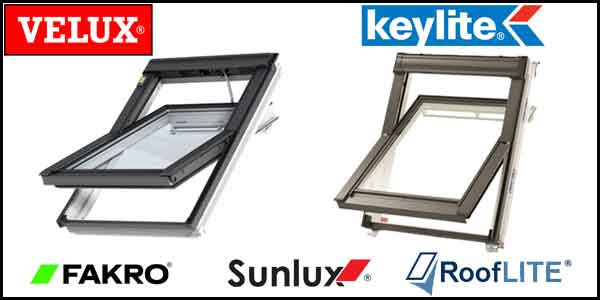Velux are a brand that makes pitched roof windows. They are a great way to add natural light into any room. The product is very well-built and high quality, and the units are very aesthetically pleasing. They are also relatively easy to install and quite affordable.
Velux windows generally have a central pivot opener, or a top opener. This means they can easily be opened to allow fresh air into the room.
Whilst they are the market leader and most well-known brand, there are some good alternatives to Velux windows.
There are several companies that make very similar products. With many of these being considerably cheaper than Velux windows.
Some of the most popular Velux window alternatives include:
- Keylite
- Fakro
- Sunlux
- RoofLITE
- ECO+

Out of this list, the most popular alternative is probably Keylite. They are usually slightly cheaper, and they do offer a very high-quality product.
I have personally fitted these windows and found them very easy to work with. The installation is quite simple. In order to install them, you simply need to trim the roof timbers to the desired size, allowing a 20mm gap around, and then fit the window in place.
Each corner has a bracket that is already installed on the window. This allows you to screw the window in place. Following this, the flashing kit is relatively easy to install.
They are available to purchase from many large DIY stores and builders’ merchants. These include:
- Screwfix
- Wickes
- Travis Perkins
- And several others
You can even buy direct from Keylite on Amazon here. This can also be purchased with a 0% payment plan over 6 months
3 benefits of Keylite windows as an alternative to Velux windows
The glazed unit in Keylite windows offer the same thermal value as a Velux window. The company also offers a 10-year guarantee on their products. Plus they look great, and they cost less.
But you may be wondering if there are any further benefits, other than price.
Personally, there are three things that stood out for me, when I compared Keylite windows with Velux windows.
The fixing brackets are already attached to the window
Anyone that has fitted a Velux window will know, these are usually loose and need attaching by the fitter. Instructions are provided, and how the brackets are attached, will depend on the type of roof you are installing in.
Keylite windows on the other hand already have brackets fitted to the window. These can be adjusted based on the roof type, but essentially all you need to do is fold them out. This is obviously a time saver, plus it’s also slightly easier to get the window out of the opening, without catching the brackets.
Spring loaded hinges
With a Velux window, the hinges in the middle of the glazed unit are loose, and they move about freely. If you do take the unit out of the frame (making it easier to fit), getting it back in can be a nightmare.
The hinges on either side of a Velux window move, and it is difficult to get them to both slot into the guide rails on the frame at the same time.
With Keylite windows, these hinges are spring loaded, rather than loose and free to move around. As a result, you can usually slide them in together first time.
Again, just like the brackets, this is a nice little time saver and makes fitting the window that little bit easier.
Built in thermal collar
When you fit your window, the manufacturer recommends a 20mm gap between the edge of the window frame and the roof timbers. Once your roof window is installed, this gap can result in a cold strip around the window. This can lead to condensation and eventually mould.
The gap around the window can be filled with a thermal collar, to stop thermal bridging. All window manufacturers including Velux, provide this as an additional add on. These need to be purchased separately and do not come as standard. Therefore, it is often not added.
Keylite have an innovative solution to this, with a built-in foam collar. The foam is covered by a layer of plastic and is activated after the window is installed.
Once installed, you simply pull away the plastic and expose the foam. At this point, it begins to expand into the gap, completely filling the void between the window frame and the roof.
For me this is such a great feature. The fact that its free, built into the window, and is so easy to activate is definitely a hat off moment to the team at Keylite.
Conclusion
There are several alternatives to Velux windows.
Whilst they are the market leader, and there is no doubt they provide fantastic products, I am still a big fan of Keylite as a very good alternative. The price is better, the window quality is comparable, and the extra little features are an added bonus. This is why I would choose Keylite as my favourite alternatives to Velux windows.




